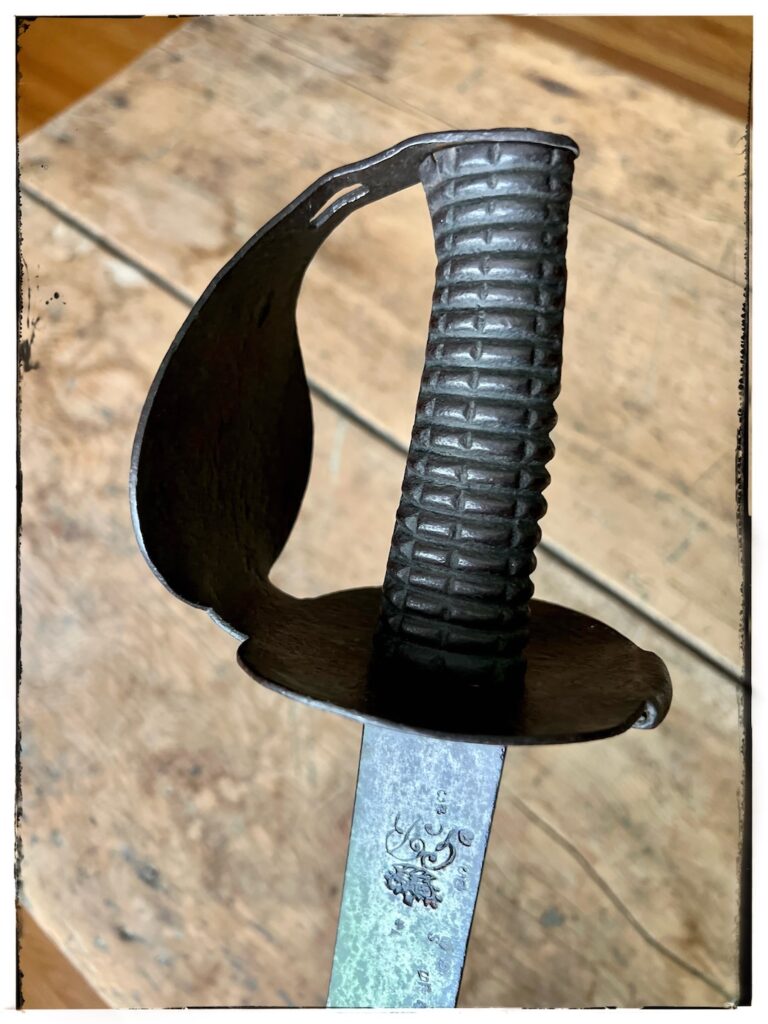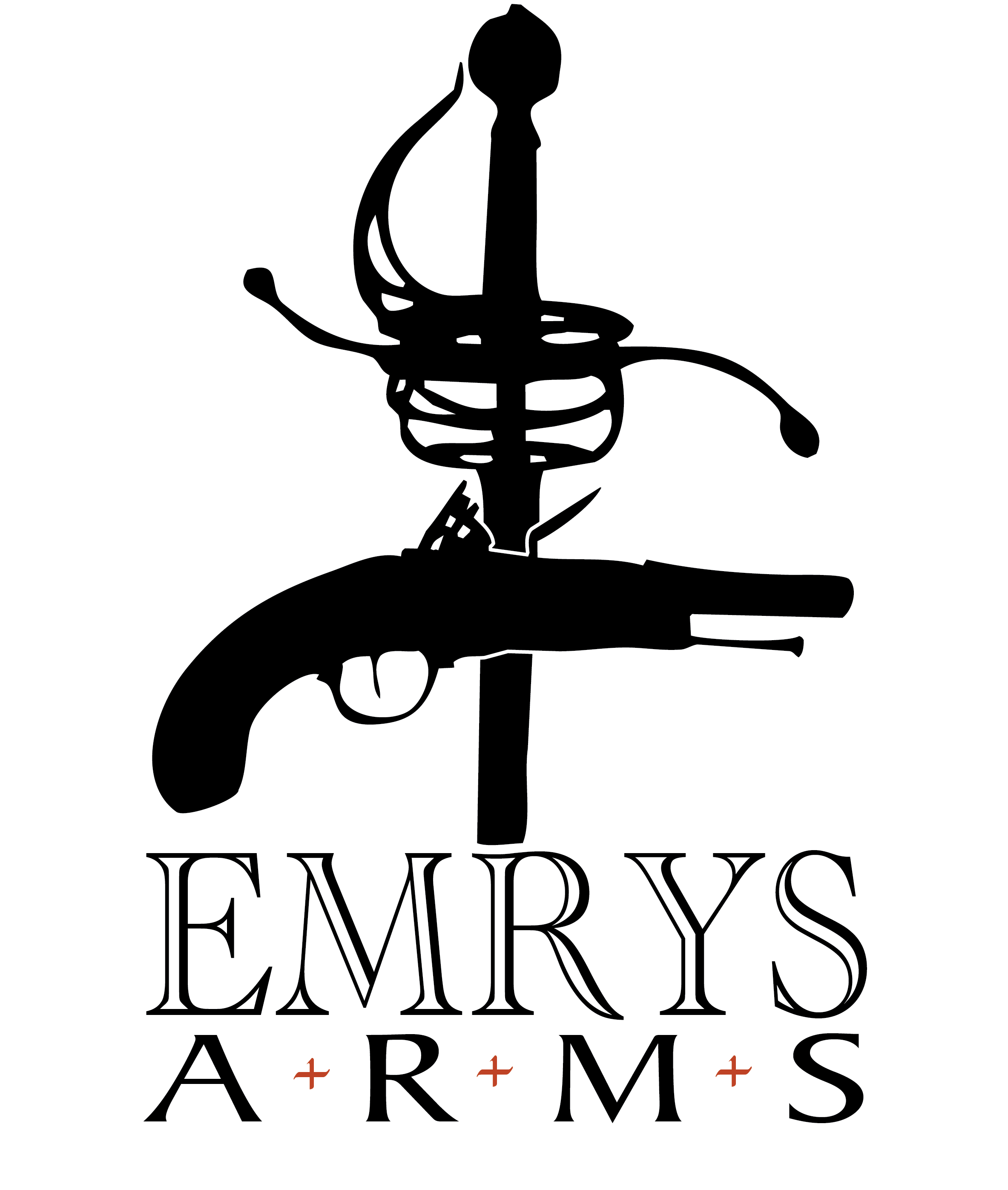| Collection #: | 2023.002 |
|---|---|
| Type: | Cutlass |
| Nationality: | British |
| Pattern: | 1804 Pattern |
| Date: | 1804(8) - 1814 |
| Hilt: | Black Painted Steel - Figure of Eight |
| Blade Length: | 73.2cm (28.82") |
| Blade Width: | 3.7cm (1.46") |
| Overall Length: | 86.7cm (34.13") |
| Maker: | Osborn & Gunby |
| Blade Markings: | GR Royal Cypher, Maker's mark on spine and numerous inspection stamps |

A stout, sharp, straight, solid fighting sword. That is what this is. Nothing fancy. The sheet steel guard composed of two discs (one around the blade and one integrated into the knuckle guard) wraps up to the top of the grip where it is riveted. The grip itself is cast iron with ribs for better grip. The style of the two discs on the guard has led it to sometimes being referred to as a figure of eight guard. On the out-facing base of the guard is the quillen, formed of sheet metal, 3.5 cm wide and rolled under itself.
The blade on this example is straight and unfullered. Some minor pitting over the length of the blade. Someone has attempted to sharpen the blade with (possibly) a modern grinder. The right-hand side of the blade is littered with multiple markings. The most prominent marking is the large crown over GR for King George III to denote Government ownership. All around it are numerous inspector marks which consist of a crown over 3, a crown over 5 and what appears to be a crown over S – seven inspector stamps in total. On the spine of the blade is the maker’s stamp of Osborn & Gunby which dates this example to 1804 – 1814.
This example is in remarkably good condition with just a small amount of movement of the guard to the blade/grip, which is solid. The blade does show evidence of being resharpened – recently? Hard to know. A gentle conservation has been conducted on the blade to stabilize the active rust and has allowed us to make out the markings on the blade a little easier. The left side of the blade contains no further markings. There is some oxidation to the blade which makes the recent evidence of sharpening suspicious. All in all, a quality piece and a very nice example of this early 19th-century British Naval cutlass.
In most examples, the blade is straight and flat with no fuller, though some few are found with a single narrow fuller just below the spine. This narrow fuller style in British blades had mostly died out by 1800 and therefore these examples may be refurbished pre-1804 cutlasses which in initial appearance were quite similar, the most obvious difference being the smooth tubular grip on the older model.
There are some suspicions as to why the blade was left unfullered as fullering typically strengthened the blade. “It may be that this was done for cheapness, but it is possible that consideration was being given to the secondary role of the cutlass in cutting through nets and cordage to get at the enemy, severing cordage on which the enemy depended and cutting away fallen rope and canvas in one’s own ship. Here the added weight of a blade without a groove would make it a more useful tool for these purposes”.
– McGrath, John & Barton, Mark, British Naval Swords & Swordsmanship, pages 27 – 28.
The origin of this sword first appears “on 30 May 1804 [when] the Board of Ordnance ordered 10,000 Swords for Sea Service to be made to a new pattern suggested by Henry Osborn. The price was 4/10d [4 shillings and 10 pence] each without the scabbard. No details of the design have been traced, neither has the Admiralty’s agreement to the new pattern. It is evident that this cutlass had the two-disc hilt and a straight 29in. flat blade. The grip was of cast iron with both vertical and horizontal grooves”.
– May, Commander W.E., RN & Annis, P.G.W., Swords for Sea Service (Volume One), page 79.
As to dating the time frame of this blade – that is trickier. According to Langham’s British Sword Research, business listings for Osborn & Gunby date from 1808 to 1820. John Gunby apprenticed under Henry Osborn and completed his apprenticeship in 1788.
The Board of Ordnance made two primary purchases of these cutlasses – the initial purchase (of 10,000) in 1804 and another (for 20,000) in 1808. Osborn was listed as supplying a portion of each purchase, but there was no listing for Osborn & Gunby. However, there was evidence of other manufacturers supplying cutlasses that also were not listed. The question as to the dating of this blade – do we presume 1804 and that Osborn & Gunby made the first batch and it was shortened down to just Osborne (being the more prominent partner), or do we go with the 1808 business listing, mentioned above, – noting that it was still listed as just Osborn and not Osborn & Gunby.
In 1814 the style of the 1804 pattern was slightly altered. The main difference was that the blade was slightly curved. There are few examples of this alteration. According to the book Swords for Sea Service Vol. I, there were no cutlasses purchased by the Board of Ordnance between 1816 and 1841.
Therefore our earliest dating of this blade could be anywhere between 1804 (when we know Gunby was working with Osborn), to 1808 when we have our first official business listings of Osborn & Gunby. Its latest period of manufacture cannot surpass 1814, even though Osborn & Gunby continued their partnership until 1820 at which point Gunby declared bankruptcy, thus ending their partnership.
For further reading on this pattern of cutlass and others, in addition to the two books I have quoted here, a third excellent (but out of print) book on the topic is William Gilkerson’s Boarders Away. Information on this specific pattern can be found on pages 84 – 85.
To see another example of this historic naval cutlass on Emry Arms, follow this link.
Read the full accounts of what these authors have recorded:
For additional research or references on this pattern:
For further visual research, feel free to look up the following books for photos of other examples of this sword.
We use cookies to improve your experience on our site. By using our site, you consent to cookies. Enjoy the cookies...they're delicious...
Websites store cookies to enhance functionality and personalise your experience. You can manage your preferences, but blocking some cookies may impact site performance and services.
Essential cookies enable basic functions and are necessary for the proper function of the website.
Statistics cookies collect information anonymously. This information helps us understand how visitors use our website.
Google Analytics is a powerful tool that tracks and analyzes website traffic for informed marketing decisions.
Service URL: policies.google.com (opens in a new window)

